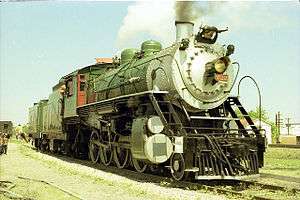Southern Railway 722
| Southern Railway No. 722 | |||||||||||||||||||||||
|---|---|---|---|---|---|---|---|---|---|---|---|---|---|---|---|---|---|---|---|---|---|---|---|
 Southern Railway No. 722 at Macon, Georgia in the mid 1970s | |||||||||||||||||||||||
| |||||||||||||||||||||||
| |||||||||||||||||||||||
| |||||||||||||||||||||||
| |||||||||||||||||||||||
Southern Railway No. 722 is a steam locomotive built in September 1904 by the Baldwin Locomotive Works for Southern Railway.[2]
History
No. 722 was used on Southern's Murphy Branch to pull logging trains between Asheville, North Carolina and Murphy, North Carolina until it retirement from revenue freight service by Southern in August 1952.[3][4]
In November 1952, No. 722 and classmate No. 630 were both purchased by the East Tennessee and Western North Carolina Railroad (ET&WNC) and renumbered No. 208 and No. 207, respectively.[5][6] Originally, the ET&WNC General Manager Clarence Hobbs offered Ks-1s No. 685 (Baldwin, 1904) and No. 835 (Baldwin, 1906), but he found that No. 630 and No. 722 are in better condition than No. 685 and No. 835.[4][6] Before the two Ks-1 locomotives were about to be moved to the ET&WNC, Southern cut down the size of their tender's coal bunker to make sure that it would be easier for the engineer to get a better view during numerous switching moves and reverse operation.[6]
In late 1967, No. 208 (No. 722) and No. 207 (No. 630) were both traded back to the Southern Railway for use in their steam excursion program in return for a pair of former Central of Georgia ALCO RS-3s.[7] While they retrieved their old numbers, No. 722 had a cracked firebox, but No. 630 was in better condition, and has been given minor repairs as it began excursion service in February 1968.[8] Two years later, No. 722 had its firebox repaired, a steamboat style whistle equipped, and a new paint scheme of Southern's Sylvan green with gold linings to match the fellow excursion locomotive No. 4501.[9] It made its first debut in 1970 with No. 630 and No. 4501 for the National Railway Historical Society (NRHS) convention in Charleston, South Carolina.[9]
In May 1979, Southern loaned No. 722 to the Wilmington and Western Railroad (WWRC) to operate on their Wilmington and Northern Branch line.[10][11][12] In September 1980, Southern loaned the locomotive again, this time to the Tennessee Valley Railroad Museum (TVRM) in Chattanooga, Tennessee along with No. 630 to make way for larger steam locomotives such as Canadian Pacific No. 2839, Texas and Pacific No. 610, and Chesapeake and Ohio No. 2716 to pull the longer and heavier excursions on Southern's system.[10]
In November 1985, No. 722 was taken out of service for its boiler ticket certificate and sat on display at the museum.[10][13] In 1992, the locomotive was moved to Asheville, North Carolina by Steam Operations Manager Carl Jenson of Southern's successor, Norfolk Southern (NS) to be on display at the city's Biltmore section.[10][13] In late 1999, NS has sold the Biltmore property for redevelopment and removed No. 722 from her display site to the Asheville roundhouse for storage.[13][14]
2000–present
In December 2000, the Great Smoky Mountains Railroad (GSMR) purchased No. 722 and returned it to the same Murphy Branch from which the locomotive was used in revenue service many years ago.[14] Today, No. 722 remains disassembled outside the GSMR Dillsboro, North Carolina workshop area along with another 2-8-0 steam locomotive ex-USATC S160 Class No. 1702, which hadn't been operated since its retirement in 2004 until returning to operational service in summer 2016.[15][16][17] In addition, the cost for No. 722's restoration is $700,000.[18] As of 2016, there are no plans for the restoration of this locomotive.[1]
References
- 1 2 "Once the 1702 & 722 trains are restored, what operational changes do you plan on making?". Great Smoky Mountain Railroad. Retrieved December 9, 2016.
- ↑ Waite (2003), p. 302.
- ↑ "Steam Engine Number "722" Returning Home to WNC and Back to Service". Asheville.com. Archived from the original on May 2, 2001. Retrieved April 4, 2018.
- 1 2 Waite (2003), p. 234.
- ↑ Ferrell (1991), p. 196.
- 1 2 3 Waite (2003), p. 238.
- ↑ Ferrell (1991), p. 199.
- ↑ Wrinn (2000), p. 21.
- 1 2 Wrinn (2000), p. 32.
- 1 2 3 4 Wrinn (2000), pp. 54–57.
- ↑ Wrinn (2000), p. 114.
- ↑ Vazquez (2008), p. 43.
- 1 2 3 "Fourth Quarter 1999 News". SteamCentral. 1999. Archived from the original on March 24, 2018. Retrieved March 24, 2018.
- 1 2 Wrinn (2000), p. 109.
- ↑ "Current status of GSMR Steam". Great Smoky Mountain Railroad. October 29, 2012. Retrieved February 24, 2017.
- ↑ "Great Smoky Mountains Railroad announces historic partnership with Swain County for revival of Steam". Great Smoky Mountains Railroad. September 25, 2012. Retrieved February 26, 2017.
- ↑ "The Steam of the Smokies has Returned!". Restoring1702. August 6, 2016. Retrieved March 3, 2017.
- ↑ "Fellow Steam Patrons and Railroad Fans". Great Smoky Mountains Railroad. August 9, 2012. Retrieved January 19, 2017.
Bibliography
- Ferrell, Mallory Hope (1991), Tweetsie Country (1st ed.), The Overmountain Press, ISBN 978-0932807588
- Wrinn, Jim (2000), Steam's Camelot: Southern and Norfolk Southern Excursions in Color (1st ed.), TLC Publishing, ISBN 978-1883089566
- Waite, John (2003), Blue Ridge Stemwinder: An Illustrated History of the East Tennessee & Western North Carolina Railroad and the Linville River Railway (1st ed.), Overmountain Press, ISBN 978-1570722721
- Vazquez, Gisela (2008), The Wilmington and Western Railroad (Images of Rail: Delaware) (1st ed.), Arcadia Publishing, ISBN 978-0738553627
Further reading
- Tillotson, Curt, Jr. (2005). Southern Railway Steam Trains: Volume 2 - Freight (1st ed.). TLC Publishing. ISBN 0-9766201-5-4.
External links
- 722's Blueprint Design Southern Railfan
- Southern Railway Steam Program HawkinsRails.net
